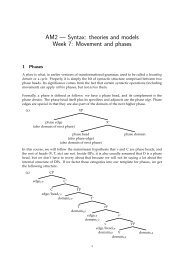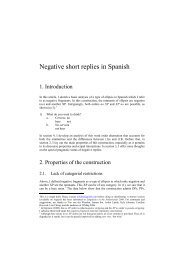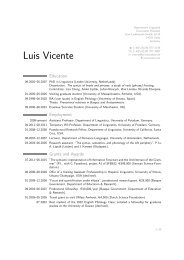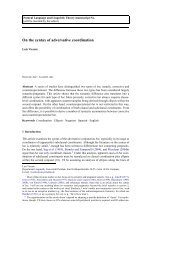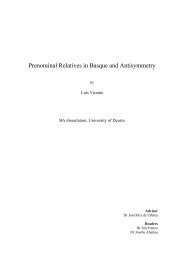Verb fronting in Mandarin Chinese - Luis Vicente
Verb fronting in Mandarin Chinese - Luis Vicente
Verb fronting in Mandarin Chinese - Luis Vicente
Create successful ePaper yourself
Turn your PDF publications into a flip-book with our unique Google optimized e-Paper software.
Cheng & <strong>Vicente</strong><br />
<strong>Verb</strong> <strong>front<strong>in</strong>g</strong> <strong>in</strong> Mandar<strong>in</strong><br />
UCSC L<strong>in</strong>guistics Colloquium<br />
October 31, 2008<br />
In this talk. ..<br />
• If we obviate double pronunciation, verbal clefts and verbal lian...dou have the exact same<br />
syntax as regular clefts and verbal lian...dou.<br />
• Several tests show that the two verbs are l<strong>in</strong>ks of one and the same movement cha<strong>in</strong>, as <strong>in</strong><br />
several other languages where comparable constructions exist.<br />
• Despite these similarities, verbal clefts and verbal lian...dou sentences differ on the trigger of<br />
double pronunciation.<br />
2 <strong>Verb</strong>al clefts<br />
2.1 Brief survey of Mandar<strong>in</strong> clefts<br />
Mandar<strong>in</strong> clefts are focus constructions built around the copular verb shi. Focus falls on the constituent<br />
immediately follow<strong>in</strong>g shi.<br />
(11) a. zhei ben shu shi [ FOC ta] kan-le, keshi...<br />
this cl book cop he read.asp but<br />
“This book, it is he who read it, but...”<br />
b. shi [ FOC Zhangsan] zuotian kandao Wang xiaojie, bu shi<br />
cop Zhangsan yesterday see Wang ms not cop<br />
“It is Zhangsan who saw Ms. Wang yesterday, not Lisi”<br />
[ FOC Lisi]<br />
Lisi<br />
Cheng (to app.a) proposes that clefts are <strong>in</strong>verse predication structures: shi takes a small clause<br />
complement, whose pro predicate raises to the left of shi.<br />
(12) Structure of shi sentences<br />
a. shi [[subject] [pro]]<br />
b. [pro] shi [[subject] [ t ]]<br />
(13) a. Shi wo<br />
cop I<br />
“It is me”<br />
b. [pro] [shi [ SC wo t]]<br />
Constituents belong<strong>in</strong>g to the small clause subject can also appear to the left of shi (float<strong>in</strong>g shi)<br />
These constituents are <strong>in</strong>terpreted as topicalized.<br />
(14) a. Zhangsan [shi [ FOC zuotian ] kandao Wang xiaojie]<br />
Zhangsan cop yesterday see Wang ms<br />
“It is yesterday that Zhangsan saw Ms Wang.”<br />
b. Zhangsan zuotian [shi [ FOC kandao] Wang xiaojie]<br />
Zhangsan yesterday cop see Wang ms<br />
“It is see<strong>in</strong>g that Zhangsan did to Ms Wang yesterday”<br />
3 of 13



